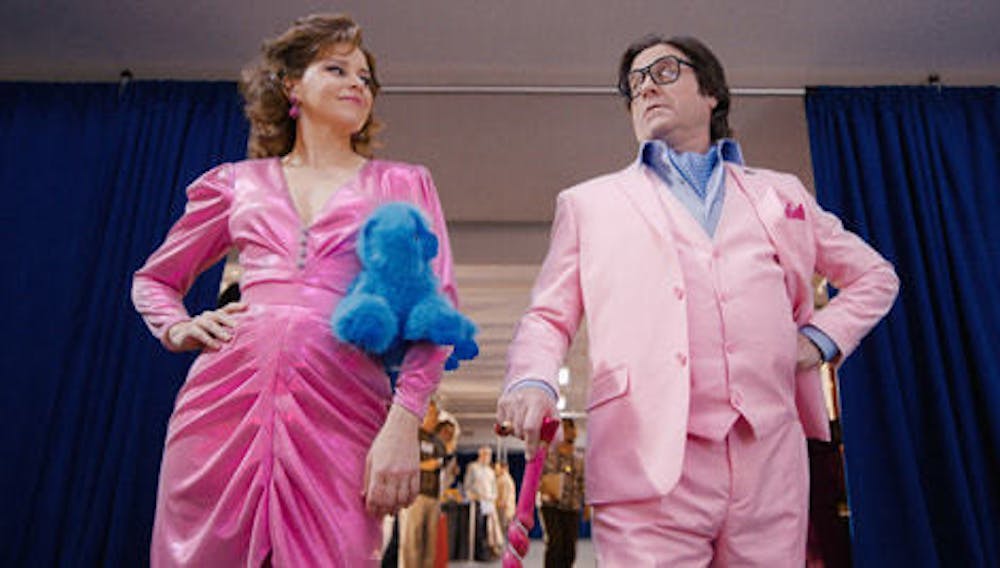Films based on real life are like a fluorescent billboard on a desolate stretch of highway: They tend to be attention-grabbers. While some people find movies based on real life absolutely irresistible, most are at least intrigued by the simple promise of a true story. “The Beanie Bubble,” a fictionalized documentary following the rise of Beanie Baby stuffed animals in the ’90s, works this exact magic. The this-actually-happened allure of the film is its main strength, driving viewers to both press play and keep watching.
“The Beanie Bubble” centers Ty Warner (Zack Galifianakis), co-founder and CEO of Beanie Baby manufacturer and distributor Ty Inc., as its main character. Just about every aspect of his portrayal in the film works against him. He is portrayed as a critical and self-absorbed man who has consistently neglected to credit the women in his life, all of whom were at one point central to his company’s success. There is Robbie (Elizabeth Banks), Ty Inc. co-founder and his on-again, off-again girlfriend of many years; Maya (Geraldine Viswanathan), an online marketing pioneer; and Sheila (Sarah Snook), a single mom who eventually becomes his fiance. Though these three women are all in drastically different places in their own lives, Ty’s selfish treatment of them is enough to keep their stories connected. Gradually, they learn to see his charm for what it really is: childish narcissism.
“The Beanie Bubble” jumps around in time to keep all three storylines relevant. The entire film spans over a decade, starting with Robbie and the creation of Beanie Babies in the ’80s and ending with Sheila and the brand’s economic crash in the ’90s. These jumps are clear, easy to follow and often intersect in interesting ways, creating an almost circular story in which beginnings turn out to be endings. Maya’s initial hiring at Ty Inc., for instance, is later revealed to be the moment when Robbie finally leaves the company. Here, Robbie is ahead of Maya in not only her age but also her understanding of Ty’s character. While she now sees him for the fraud that he is — one who constantly takes credit whenever it’s not due — Maya will suffer years of being overworked and underpaid before coming to the same conclusion.
That the film’s cast is relatively small works in its favor, as this gives each character more space to succeed. Galifianakis brings some of his typical comedic relief in moments like his musical proposal to Sheila, but his performance is always tainted with the disgusting behavior of a narcissist who would — and at one point does — steal credit for the creation of certain Beanie Babies from a child. Banks is vengeful with taste, while Viswanathan continues to make a name for herself at the beginning of a budding career. And “Succession” star Snook is wonderful to watch, as usual — although it’s hard not to miss Shiv Roy whenever she’s on screen.
For all of the hard work done by its cast, “The Beanie Bubble” is still a breezy watch. Scenes that are meant to be confrontational often lack a certain intensity, but it’s hard to expect anything else. Ultimately, the film is still about a man-child who created a company to sell stuffed animals.
Like many films based on real life, “The Beanie Bubble” has a habit of interspersing spliced clips of actual news footage following the rise and fall of the brand. These montages serve to underscore the reality of the story, even though the film’s opening credits make clear that not all events depicted in it are true. But the specifics of what actually happened versus what didn’t are not so important as to prevent “The Beanie Bubble” from getting its main points across. It is, at the end of the day, a classic microcosm of an American economy in which people continue to speculate, undervalue women and watch bubbles burst.

Rya is an Arts & Culture editor from Albany, NY. She is a senior studying English and Literary Arts, and her favorite TV show is Breaking Bad.





